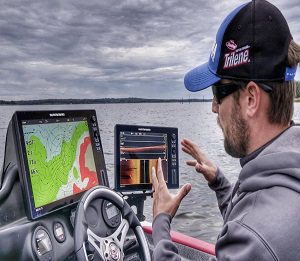 As a matter of fact, most fish finders are just not created equal. Well, many of the top bass anglers refer to an amazing deal of the monitors as “junk.” As per experts, some of them are just useless pieces of device, they actually do not hold have enough power or pixels.
As a matter of fact, most fish finders are just not created equal. Well, many of the top bass anglers refer to an amazing deal of the monitors as “junk.” As per experts, some of them are just useless pieces of device, they actually do not hold have enough power or pixels.
If they are not capable of enough power or pixels they would display false readings. Now the problem is that crappy ones will guide you that there is a fish everywhere around when you turn them on. And guess what? there are not. As mentioned earlier, Not all types of fish finders are equal.
It would be wise to consider the model that is equipped with enough pixels in the screen where you can really distinguish what’s happening there, Many fishing professionals recommend that anglers should prefer a unit with at least a pixel count of 480×480.
How to use a fish finder for bass?
The process of using a fish finder in an effective way is quite simple and easy. It will surely help you find more bass and provide you with a visual of the kind of structure you are fishing. But, you must consider a few concepts to understand first, which we will cover briefly here.
Important settings to know while using a fish finder for bass
Bass fishing technology has offered some advanced features that have made this fishing much easier than ever before and, with lighter, smoother reels, stronger rods, and a better line that is really tough yet nearly invisible, the Bass fishing technology has changed the way people used to hunt fish. The interesting part is that even lures, which used to be metal, wood, or plastic, are becoming one of the great wonders of 21st-century engineering.
Well, it makes sense to debate over the importance and effectiveness of certain fishing technologies but you just can’t argue with the significance of a digital fishfinder.
Bass fishing is considered one of the most popular and enjoyable sports in the country, if you are interested in reeling in more fish, win big tournaments, and have to become a better bass angler, it is important to have a fish finder, and you must know how to use it.
Adjust the sensitivity to 100%
As most of us prefer to keep things simple, It would be better to adjust the sensitivity of the fish finder in such a way that it hits on fish but does not go off on each and every small spec in the water. Now turn off automatic mode, after that just manually adjust the sensitivity to 100%. Once you are done with this, now just slowly dial it down until you detailed information on the bottom.
Use basic settings
The latest fish finders that are equipped with advanced features come with hundreds of applications, settings, and tools. Now the issue is that with so many combinations and infinite streams of information, they are just overwhelming.
While the best practice, at least when starting is to set your fishfinder to the most basic settings. Try to master how to judge spot fish, depth, locate weeds and structure. Once you have a strong grip over basic settings then you can start trying the advanced settings.
Find Steep Drop-offs
As you might already know that ledges and Steep drop-offs are areas that will hold an immense amount of fish. In order to search these locations, start moving slowly away from shore, pay attention to the depth and bottom structure as you move forward. If you notice the bottom sloping down, now just fish the area by casting heavy spinners or deep-diving crankbaits that will swim along with the ledge.
Make the use of water temperature feature
Among the most effective indications, Water temperature is a major major one that helps to determine the behaviour of fish, you are very lucky if your fish finder is equipped with this feature, as most latest advanced products are. It is important to note that this will be most useful in the spring, when bass gathers in warm waters, near shallow areas.
Spot irregularities and changes
Those people who use a fish finder to spot irregularities, changes, and structure, are on the right track. Such areas that have turns, points, and usual changes in the bottom terrain are mostly loaded with bass, the issue is that these spots are hard to find near the shoreline.
Like many others, you can also try to use it to find artificial fish cribs, which are considered man-made underwater structures, like logs structures specially designed with a purpose to provide baitfish with a spawning area.
Conclusion
The above-mentioned settings and effective use of features will provide you ease in finding bass through a fishfinder. There are a few other features as well that could help in understanding how to use a fish finder for bass: such as screen display, side-scan sonar, and understanding downs.
- What Do You Need for Fishing - August 18, 2022
- How to Find Offshore Fishing Spots - August 18, 2022
- What to Use for Trout Fishing - August 17, 2022
